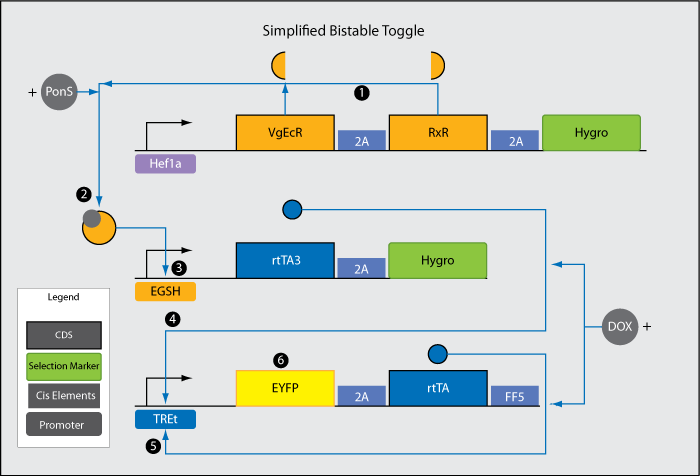Team:MIT mammalian Switch
From 2010.igem.org
(Difference between revisions)
| Line 62: | Line 62: | ||
<table width=650px style="background-color: white; margin-top:5px; padding: 10px;"><tr><td><div class="bodybaby">Synthetic Switch: Implementation of Bistable Toggles in Mammalian Cells</div></td> | <table width=650px style="background-color: white; margin-top:5px; padding: 10px;"><tr><td><div class="bodybaby">Synthetic Switch: Implementation of Bistable Toggles in Mammalian Cells</div></td> | ||
| - | < | + | <tr><td>It is useful for a synthetic system capable of sensing mechanical stimuli to be able to convert a transient signal into a constitutive response. During the summer we designed both a complete and a simplified bistable toggle with a low and high output state using positive feedback loops. |
| + | |||
| + | <img src="https://static.igem.org/mediawiki/2010/1/1d/Simplified.png" width=100%> | ||
| + | <p> | ||
| + | <center>(Click on picture to view larger version)</center> | ||
| + | <br>1. Hef1a promoter leads to low level, constitutive expression of the two halves (VgEcR and RxR) of a receptor responsive to the chemical ponasterone A (PonS). | ||
| + | <br>2. VgEcR, RxR, and PonS combine to form an active complex. | ||
| + | <br>3. EGSH is induced by the VgECR-RxR-PonS complex. | ||
| + | <br>4. rtTA3 is transcribed after teh activation of EGSH. | ||
| + | <br>5. Each rtTA3 binds to two of the six tetO sites in the TREt promoter and induces the promoter. | ||
| + | <br>6. rtTA, another version of rtTA3, further induces activation of the TREt promoter. This establishes a positive feedback loop, which propels the system from a low to a stable high output state. In the high output state, EYFP is constitutively expressed at a high level. | ||
| + | </td> | ||
| - | |||
<tr><td> | <tr><td> | ||
Revision as of 10:12, 27 October 2010
Synthetic Switch: Implementation of Bistable Toggles in Mammalian Cells |
It is useful for a synthetic system capable of sensing mechanical stimuli to be able to convert a transient signal into a constitutive response. During the summer we designed both a complete and a simplified bistable toggle with a low and high output state using positive feedback loops.

1. Hef1a promoter leads to low level, constitutive expression of the two halves (VgEcR and RxR) of a receptor responsive to the chemical ponasterone A (PonS). 2. VgEcR, RxR, and PonS combine to form an active complex. 3. EGSH is induced by the VgECR-RxR-PonS complex. 4. rtTA3 is transcribed after teh activation of EGSH. 5. Each rtTA3 binds to two of the six tetO sites in the TREt promoter and induces the promoter. 6. rtTA, another version of rtTA3, further induces activation of the TREt promoter. This establishes a positive feedback loop, which propels the system from a low to a stable high output state. In the high output state, EYFP is constitutively expressed at a high level. |
 "
"
 iGEM 2010
iGEM 2010